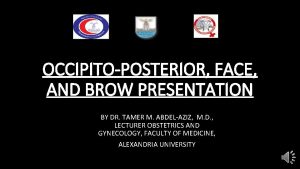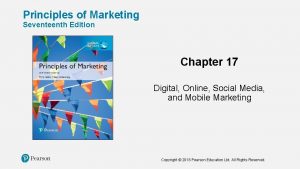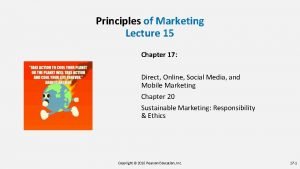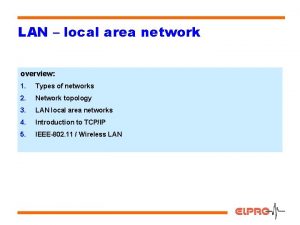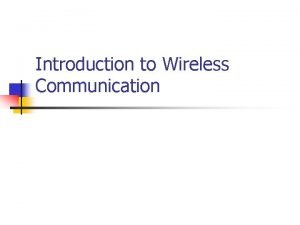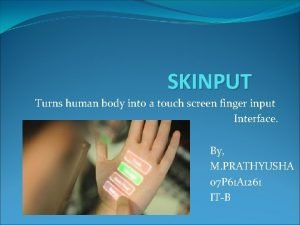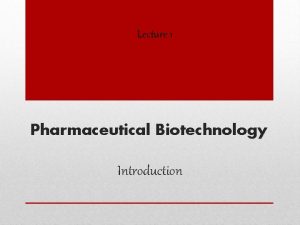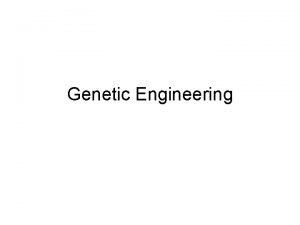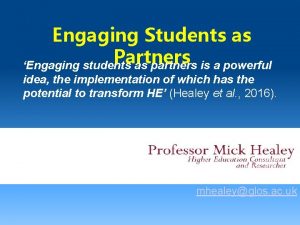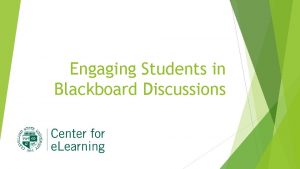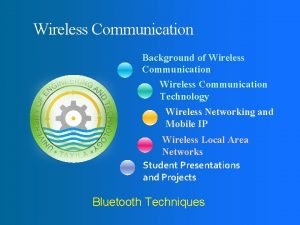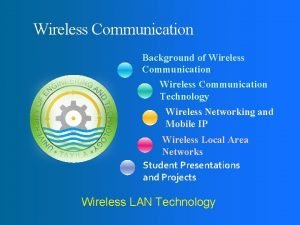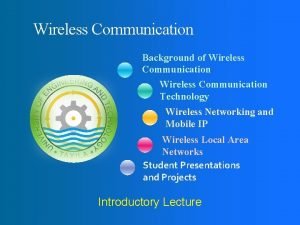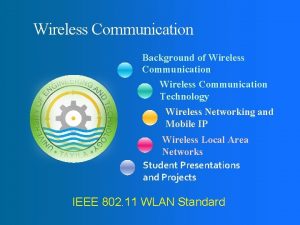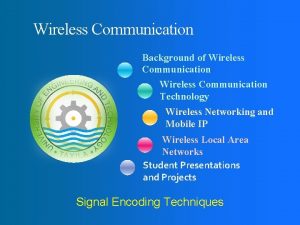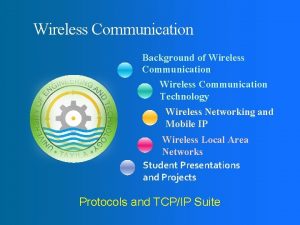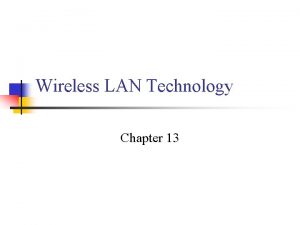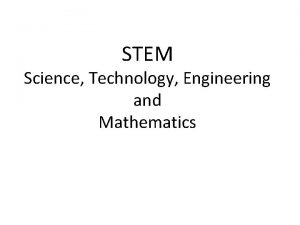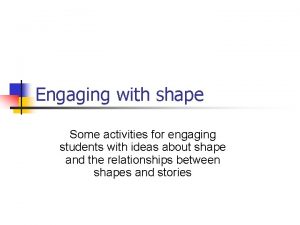Engaging Science Students with Wireless Technology and Applications















- Slides: 15

Engaging Science Students with Wireless Technology and Applications by Re-visiting the Thayer Method Richard Pennington, David Pursell, Joseph Sloop School of Science and Technology

Do you enjoy Chemistry? 1. 2. 3. 4. 5. 6. Love It! I like it. It is okay. Not really a fan. It is horrid. I never took Chemistry. School of Science and Technology

Georgia Gwinnett College GGC Vision 1 Ø learning takes place continuously in and beyond the classroom Ø innovative use of educational technology Ø integrated educational experience that develops the whole person Ø dynamic learning community Ø faculty engagement in teaching and mentoring students Ø innovative approaches to education SST Mission 2. . . provides an innovative, engaging, outcomes-based learning experience for students in science courses. . . (charge from Dean Thomas G. Mundie) 1 Georgia 2 School Gwinnett College Web page, http: //www. ggc. usg. edu/about-ggc of Science and Technology Mission, http: //www. ggc. usg. edu/academics/school-of-science-and-technology School of Science and Technology

Thayer Method Tenets 3 Ø Ø Ø Ø Students are responsible for their learning Learning is incremental and sequential Small class size (~ 20 students) Students prepare in advance of class/lab attendance Instructor facilitates student learning before, during, and after class/lab Minimize lecture; maximize active, student-directed, collaborative learning Detailed syllabus with course and lesson outcome goals, study assignments, homework problems, and learning support tools Ø In class boardwork: • student ownership and responsibility for their actions in the classroom, • students demonstrate mastery in a formal process • students “publish” and defend Ø Frequent assessment and feedback 3 a. Academic and Military Programs of the Five Service Academies, Comptroller General of the United States, Report to Congress: 31 October 1975, pp. 48 -52. b. Palladino, George F. J. Chem. Educ. 1979, 56, 323. c. Ertwine, Dean R. ; Palladino, George F. J. Coll. Sci. Teach. 1987, 16, 524. d. Gibson, Robert. J. Coll. & Character 2007 VII (3), 1 -8. e. Shell, Amy E. Primus: Problems, Resources, and Issues in Mathematics Undergraduate Studies 2002 12(1), 27 -38. f. Pursell, David P. Cell Biology Education-Life Sciences Education, 2009, 8, 15 -28. School of Science and Technology

How We Help Students Prepare before Class Provide Students: Ø Detailed syllabus • Admin info • College Integrated Educational Experience (IEE) Goals • Academic Program Goals • Course Goals • Lesson Objectives • Daily lesson outline w/study assignment, terms, HW problems Ø Student-friendly text and solutions manual Ø Blackboard site with all course materials Ø Flash cards 4 (computer or handheld device operable) Ø Airliner videos (computer or handheld device operable) Ø Cell phone text/voice messaging 24/7 4 Pursell, David P. . J. Chem. Educ. 2009, 86, 1219. School of Science and Technology

Example Daily Lesson Outline Spring 2010 – CHEM 2212 Organic Chemistry II – Daily Lesson Objectives Alcohols, Phenols and Thiols; Ethers and Sulfides (Ch. 13) Day 1 (1/11/10) – Introduction to CHEM 2212 / Start of Chapter 13 • Read Ch. 13. 1 - 13. 2 • Problems before class: 13. 1 - 5 • Videos to watch in preparation for class: naming alcohols • Name and draw the structures of alcohols, phenols and thiols • Describe trends in physical properties of alcohols, phenols and thiols • Demonstrate how alcohols are both weakly acidic and weakly basic • Draw resonance structures to explain the higher acidity of phenols vs alcohols • Problems during and after class: 13. 20, 24 a-e, 25, 27, 50 Day 2 (1/15/10) • Read Ch. 13. 3 - 13. 4 • Problems before class: 13. 6 - 10, 34 • Write reactions for the preparation of alcohols from carbonyl compounds • Write mechanisms for the acid-catalyzed dehydration of 3 alcohols (E 1 mechanism) and the dehydration of 1 and 2 alcohols with POCl 3 in pyridine (E 2 mechanism) • Problems during and after class: 13. 38, 41, 45, 51, 52, 54, 70 School of Science and Technology

Video Demonstrations – Aiding in Class Preparation Cell Phone Flashcards Class Prep Podcast Videos via Cell Phone School of Science and Technology

In the Classroom No fixed agenda – Instructor guides class based on student driven discussion, questions, and issues Typical Classroom Sequence Ø Students prepare before class Ø Targeted query gauging student understanding at beginning of class Ø Student driven discussion, Q/A Ø Chemical demonstrations and discussion Ø Discussion focused on the daily lesson Ø On-the- fly instructor mini-lectures as needed Ø Student whiteboard work (individual and groups) and recitation Ø Lesson/chapter quizzes Result: maximize engagement and efficiency of instructor-student contact time School of Science and Technology

Videos of Class Activities Students asking questions Students getting up to the boards Students working up at the boards – Principles of Chemistry I Students working up at the boards – Organic Chemistry I School of Science and Technology

Table 1. End of Course Student Survey Results Respond to the statements using the scale below: [5] Strongly Agree [4] Agree [3] Neutral [2] Disagree [1] Strongly Disagree Principles Organic AVE STD 1. I was given enough information to be able to prepare for class. 4. 8 . 4 5. 0 0 2. Out-of-class assignments helped me understand concepts. 4. 6 . 5 4. 9 0. 4 3. Working homework problems before class was important to my learning. 4. 3 . 9 4. 5 0. 7 4. Viewing mini-lectures before class was important to my learning. 3. 8 1 4. 9 0. 3 5. Viewing cell phone flashcards before class was important to my learning. 2. 5 1 3. 1 1 6. Time in class helped me understand the concepts covered in this course. 4. 7 . 5 5. 0 0 7. The instructor encouraged class discussion, participation, or questions. 4. 8 . 3 5. 0 0 8. Instructor/student discussion & Q/A in class was important to my learning. 4. 7 0. 6 4. 9 0. 3 9. Working individually at whiteboards was important to my learning. 3. 9 1 4. 4 1 10. Working in groups at whiteboards was important to my learning. 4. 5 0. 8 4. 6 0. 5 11. Regular quizzes in class were important to me learning course material. 4. 0 1 4. 7 0. 7 12. Whiteboards improved my ability to work w/classmates orally & in writing. 4. 3 0. 8 4. 5 0. 9 13. By semester end, I was comfortable/confident working at whiteboards. 4. 4 0. 8 4. 8 0. 4 School of Science and Technology

Student Survey Comments Principles of Chemistry Ø Ø The whiteboards were the most important part of the learning experience for me in this class. Working along side peers and having to think critically was vital for me to comprehend and retain the material. It basically made chemistry, a difficult topic, easy. Having a solid set syllabus to follow was greatly helpful. It would be nice if other faculty adopted it. The course objective sheet given at the beginning of the semester really helped in my studies. I liked the fact that you were supposed to teach yourself ahead of time and come to class to ask questions. Organic Chemistry Ø Ø Use of technology was vital to my understanding of the course material. I couldn’t imagine the semester without it. Looking just at the book at the beginning of the semester terrified me. However, with the technology, I found out that I actually enjoy organic chemistry and I am not afraid of attempting any problem in o chem that is presented to me. The Thayer method of learning the material was one of the best I have ever been in. I did much better in this class than I did in a traditional system for Gen Chem. The mini-lectures on webct were extremely helpful. Being a transfer student, I noticed a huge increase in retention of the course material. The teaching method, though different than what I am accustomed to, was preferable to former methods!!!! School of Science and Technology

Student Audio Comments Comment #1 (Principles of Chemistry I student) Comment #2 (Organic Chemistry I student) School of Science and Technology

Conclusion SST Mission 2. . . provides an innovative, engaging, outcomes-based learning experience for students in science courses. . . (charge from Dean Thomas G. Mundie) Results Ø Students responsible for their learning, develop study discipline Ø Instructor role changes from lecturer to facilitator Ø Content on traditional, computer, and handheld platforms to enable before class preparation. Ø Student collaborative and oral/written communication skills improved Ø Instructor-student engagement maximized 2 School of Science and Technology Mission, http: //www. ggc. usg. edu/academics/school-of-science-and-technology School of Science and Technology

Do you think the Thayer method increases student engagement? 1. Yes 2. No

Do you believe the Thayer method will help student learning? 1. Yes 2. No
 What are wireless devices and the wireless revolution
What are wireless devices and the wireless revolution Brow presentation
Brow presentation Dynamisch verbinden
Dynamisch verbinden Marketing involve engaging directly with carefully targeted
Marketing involve engaging directly with carefully targeted Marketing involve engaging directly with carefully targeted
Marketing involve engaging directly with carefully targeted K5 think central
K5 think central Outdoor wireless lan
Outdoor wireless lan Telecommunications, the internet, and wireless technology
Telecommunications, the internet, and wireless technology My favorite subject is art because
My favorite subject is art because Lan type a
Lan type a Advantages of wireless transmission
Advantages of wireless transmission Jose rizal love life
Jose rizal love life Skinput
Skinput Pharmaceutical biotechnology notes
Pharmaceutical biotechnology notes Recombinant dna technology applications
Recombinant dna technology applications Genetically modified crops have
Genetically modified crops have

